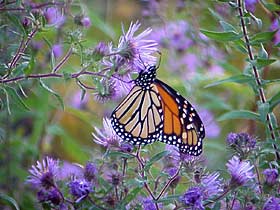Information
In my garden there is a large place for sentiment. My garden of flowers is my garden of thoughts and dreams. The thoughts grow as freely as the flowers, and the dreams are as beautiful. Is this you? Then join us here...you are welcome!
Members: 43
Latest Activity: Sep 9, 2020
Discussion Forum
MACRO FLOWER PHOTOGRAPHY 27 Replies
AgapanthusContinue
Started by Daddieo. Last reply by Daddieo Apr 8, 2017.
MEMORIES AND BOUQUETS 16 Replies
Getting into the garden is more than a work detail, although it certainly involves that, and only that, sometimes. I was thinkingof all the…Continue
Started by Daddieo. Last reply by Daddieo Oct 13, 2013.
EDIBLE LANDSCAPE RESOURCE GUIDE
Vegetables and HerbsAbundant Life SeedsBox 157 Saginaw, OR 97472-0157(541) 767-9606www.abundantlifeseeds.comOffers 100% certified organic vegetable, herb, and…Continue
Started by Daddieo Jun 9, 2013.
EDIBLE OF THE MONTH: Lemons and Limes
Winter is citrus time in much of the country. Whether you're eating citrus shipped from warmer climates or lucky enough to live in a climate where you can grow citrus yourself, now is the time to enjoy these luscious fruits.While oranges and…Continue
Started by Daddieo Jun 9, 2013.
ARTFUL FLOWERS -Paintings 2 Replies
Yellow Aquilegia (Columbine)Continue
Started by Daddieo. Last reply by Daddieo May 25, 2013.
EDIBLE OF THE MONTH: CELERIAC
At first sight, Celeriac (AKA Celery Root) is a homely oddball. If you're not quite sure what it looks like, how to use it or even how to pronounce it…Continue
Started by Daddieo Feb 19, 2013.
Reminders For December...Then, It's All Downhill 'til Spring
Store Pesticides and Fertilizers ProperlyStore clearly labelled liquid fertilizers, pesticides, and herbicides where they will not freeze.…Continue
Started by Daddieo Dec 7, 2012.
ROMANTIC COSMOS
In Focus: Romantic Cosmos When you think of Cosmos, you may be reminded of grandmotherly gardens from yesteryear~warm and sunny retreats with bees happily…Continue
Started by Daddieo May 24, 2012.
PHOTOGRAPHY IN THE GARDEN 73 Replies
A STUDY OF BEAUTY ~ ZANTEDESCHIAContinue
Started by Daddieo. Last reply by Daddieo May 22, 2012.
Comment Wall
Comment
-
Comment by Daddieo on April 30, 2012 at 9:06pm
-
Comment by Letha Robinson on April 16, 2012 at 7:24pm
-
California Sunset Sage is one of 9 new Salvias we added this year bringing our total offering to 32. With almost 700 different kinds of Salvias known to exist, we look for those that are distinctive from each other and are easy to grow. We grow all of our plants in gardens (sometimes for many years) before we offer them to you so we know how they grow and what they need to stay healthy.
Salvias are easy to care for and reward us with lots of gorgeous colors in the garden. They have the added advantage of attracting hummingbirds to the garden. Most of their flowers can be used as edible garnish if grown organically.
-
Comment by Daddieo on April 13, 2012 at 3:37am
-
I actually saw evidence of several daffs and a couple tulips making a new growth appearance. Oriental poppies along the south walls are up about 6-7 inches...it's coming, Audrey, Spring is almost here! (After a week or so of temps in the 80's, making this March the warmest on record...we have now been averaging about 15 degrees below normal for the last week or so; hence, the slow down in all new growth. Oh, well...)
-
Comment by Daddieo on April 8, 2012 at 2:16pm
-
Comment by Daddieo on April 8, 2012 at 2:15pm
-
Comment by Daddieo on April 8, 2012 at 2:14pm
-
Comment by Daddieo on April 8, 2012 at 2:12pm
-
Comment by Daddieo on April 8, 2012 at 2:11pm
-
Comment by Daddieo on April 6, 2012 at 4:28am
-
Missing Monarchs

Monarch butterflies are beautiful visitors to our gardens, but over the last fifteen years there have been fewer and fewer making an appearance. During the winter of 2009-2010, the number of monarchs from eastern North America overwintering in Mexico reached an all-time low. The numbers came up somewhat for the 2010-2011 winter, but are still low. What's behind this decline?
Researcher Lincoln P. Brower and colleagues, in an article published in the March 2012 journal Insect Conservation and Diversity, suggest three factors that have contributed to the bust in butterflies. First is the degradation of the forests in Mexico that provide overwintering habitat to the monarchs. Much of this habitat has been lost due to illegal logging in areas that have been set aside as reserves.
Another big factor is the increased cultivation of genetically modified glyphosate-resistant corn and soybeans in the U.S., which has resulted in more extensive use of the herbicide glyphosate in farm fields. This herbicide use has led in turn to a sharp decline in the milkweed plants in the fields that provide breeding habitat for monarchs.
The third factor noted is the role of extreme weather interfering with winter survival or summer breeding. For example, overwintering butterflies experienced record-breaking precipitation over the 2009-2010 winter during what is normally the dry season, which caused flooding, landslides, and high winds that wreaked havoc on their habitat. In 2009 high spring temperatures in Texas limited breeding. As the climate warms, the expectation is that these types of weather extremes will increase, further harming butterfly populations. The study's authors suggest that only with better stewardship in both the U.S. and Mexico will we be able to count on having these lovely lepidopteron visitors continue to frequent out gardens.
-
Comment by Daddieo on April 4, 2012 at 5:44am
© 2025 Created by Aggie.
Powered by
![]()
You need to be a member of Garden Friends to add comments!